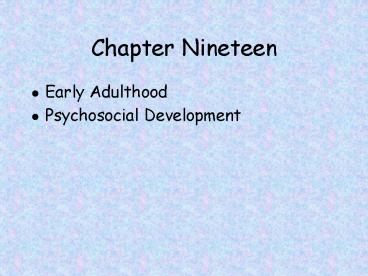Chapter Nineteen - PowerPoint PPT Presentation
1 / 31
Title:
Chapter Nineteen
Description:
Today's adult lives 'are less orderly and predictable than stage models suggest' ... of couple commitment, celebrated in every culture in the world by a wedding ... – PowerPoint PPT presentation
Number of Views:172
Avg rating:3.0/5.0
Title: Chapter Nineteen
1
Chapter Nineteen
- Early Adulthood
- Psychosocial Development
2
Tasks of Adulthood
- Two basic needs affiliation and achievement
- Maslows hierarchy of needs
3
- Ages and Stages Patterns of the past
- by 20s ? identity
- by 30s ? intimacy
- by 40s ? generativity
- Todays adult lives are less orderly and
predictable than stage models suggest
4
(No Transcript)
5
- The Social Clock
- Culturally set timetable that establishes when
various events and endeavors in life are
appropriate - What are some of the appropriate timetables for
the United States?
6
- Nation to Nation
- Industrialized nations - legal ages/requirements/e
xpectations (teenage pregnancy not good) - Underdeveloped nations - less age stratified
because survival to late adulthood less certain - Rich and Poor
- The lower the SES, the sooner a person is
expected to reach lifes milestones
7
Intimacy
- Need for intimacy
- Affiliation, affection, interdependence, love
- Two primary sources are close friendship and
romantic partnership
8
- Friendship
- Buffer against stress, guide to self-awareness
and source of positive feelings - Gateways to attraction for friendship
- physical attractiveness
- apparent availability (willingness to chat)
- absence of exclusion criteria
- frequent exposure
9
- Gender differences in Friendship
- Conversations
- Women ? self-disclosure
- Men ? external matters - sports, politics, work
- Deborah Tannens work
10
- Man and Woman, Just Friends
- cross-sex friendships allow learning about common
humanity and help each other gain skills - problems may arise when sexualizing a platonic
relationship
11
- The Best Friendships
- several close friendships, each meeting different
needs - Friendship and Marriage
- At marriage, friendships become less prominent
- Cross-sex friendships can cause problems
- Same sex can be rivals
12
Development of Love and Marriage
- Intimate relationship with a mate creates a bond
- Living together
- Cohabitation increasingly common
- Cohabitation does not strengthen bond
- People who cohabitate are much less happy,
healthy and less satisfied with financial status
than are married couples
13
- Cohabiting relationships are more abusive-
abusetwice as likely as those not living
together - Cohabitaters who eventually marry are more likely
to divorce
14
- Living with Same Sex Partner
- Homosexual cohabitation is more common and open
today - 2-5 of all adults in US spend part of adulthood
in gay or lesbian partnerships - More similar than different to cohabiting
heterosexual partnerships
15
- Sternbergs Theory of love
- 3 components 1)passion 2)intimacy 3)commitment
- 7 types of love stemming from this theory
16
(No Transcript)
17
- Marriage
- Not like it used to be
- Only 10 brides are virgins
- 32 of all births are to unmarried mothers
- 10 of first births are conceived before marriage
- Divorce rate is 49 of marriage rate
- The rate of first marriages in young adulthood
lowest in 50 years
18
- However, marriage remains the most enduring
evidence of couple commitment, celebrated in
every culture in the world by a wedding
19
- Homogamy ? within group
- Heterogamy ? out of group
- Social homogamy ? similar interests and role
preferences - Marital equity
- exchange theory
- Marriage is a work in progress communication
20
- Divorce
- Divorce rates differ by country- US highest rate
of any major country - Role of expectations
- Expect more from marriage partners than in the
past - Uncoupling
- How does it affect the development of husband,
wife and children - Initially worse in every way- health, happiness,
self-esteem, financial stability and social
interaction
21
(No Transcript)
22
- Developmental Pattern of Divorce
- First year
- anger and conflict
- social circle shrinks
- prone to loneliness, disequilibrium-
- financial instability
23
- Divorced with Children
- Children become more demanding, disrespectful or
depressed - Financial burdens
- Fathers often lose intimate bonds with children
because of physical or psychic differences - Likely to become less involved with children
every passing year
24
- Spouse abuse ? multiple causal factors
- social pressures, stress, cultural values,
personality pathologies, and drug and alcohol
addiction - couple violence - yelling, insulting and physical
attack but no domination - patriarchal terrorism- one partner domination
using isolation, degradation and punishment
25
- Remarriage
- 3 times more likely for men in the first 3 years
- Adjustments to stepfamilies take a lot of time
26
Generativity
- Importance of Work
- develops and uses personal skills and talents
- expresses unique creative energy
- contributes to larger community by providing
product or service - Volunteerism
- Family responsibilities
- Artistic Creation
27
- Pattern of the 1950s
- Historical Context of work
- New Patterns of Work
- Context changing
- Work itself changing
- Industry to information
- Diversity in the workplace
- sex, nationality and ethnicity
28
- Implications for development
- Flexibility and transferable skills- especially
communication - Need for sensitivity to cultural differences
- Glass ceiling
- Need for same human relations skills as
friendship and marriage
29
Gender Roles in Work and Family
- Shift in gender roles in the 20th century
- Benefits and problems
- Coparenting
- Role overload
- Role buffering
- Logistics in everyday life
30
Parenthood
- Adult Development
- having children, nurturing them and launching
them into the world has a major impact on the
parents development - birth of a child brings conflict and challenges
- Alternative forms of parenthood
- stepparents, adoptive parents, foster parents
31
(No Transcript)































